
Warblers
Oregon has 21 species of warblers.

Types of Warblers
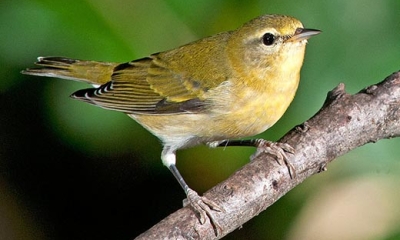
This rather plain warbler breeds across Canada from the Atlantic coast to central British Columbia and southern Alaska. The main migratory route is east of the Rocky Mountains, but small numbers regularly migrate along the west coast.
The Tennessee warbler is most often found in deciduous groves or mixed woodlots. It is similar in plumage to the Warbling vireo, though its habits are more active and warbler-like. Care should also be taken to distinguish this species from gray-headed Orange-crowned warblers.
Hear the song of the Tennessee warbler
Photo by Russ Wigh, Flickr
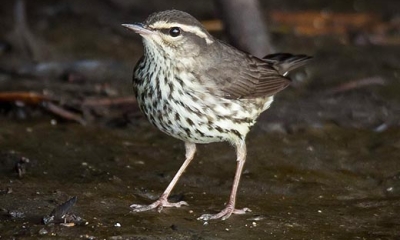
One of Oregon's rarest and most local breeders, this vocal but somewhat secretive warbler can be heard and sometimes seen in summer in the south central Cascades. The patient observer may catch a glimpse of a chunky, dark-backed bird feeding low in dense willows, sometimes showing its pale underparts with dark streaks. It is otherwise a rare migrant or vagrant statewide, mostly in Spring.
An isolated population of this species has summered and presumably bred in the south central Cascades. No nest has been found in Oregon, owing mainly to the impenetrable habitat. Reports suggest that a small population may breed in the upper Wenaha River area of Union and Wallowa counties, not far from the Idaho colonies along the St. Joe River.
Hear the song of the Northern waterthrush
Photo by Alan Harper, Flickr
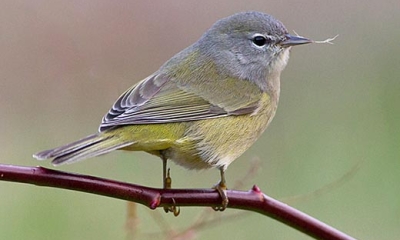
This olive-green warbler is one of the drabbest of Oregon's Warblers., often showing obscure streaking on the underparts and indistinct dark eyeline. The species is named for its telltale orange crown spot but this feature is often hidden, reduced or absent in immature and female birds, and therefore rarely observed in the field.
Orange-crowned warblers are one of the earliest and most abundant migrants in Oregon. They glean insects from the undersides of leaves and are often seen probing into dead leaf clusters and flower heads. Perhaps this is why they are able to winter farther north than most other warblers.
They are common to uncommon breeders from the coast to west slope of the Cascades, and across the Cascades in lower densities into at least Klamath and Wasco counties.
Hear the song of the Orange-crowned warbler
Photo by Fyn Kynd, Flickr
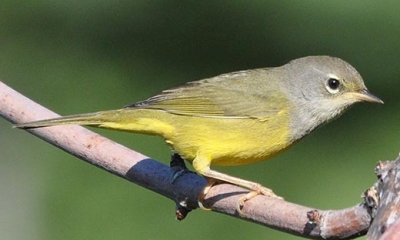
During the breeding season, this gray-hooded warbler is conspicuous, singing boldly from riparian thickets, clear-cuts, and roadside brush. However, when household cares occupy the daylight hours, they become elusive as field mice, slipping about through the thickets like shadows, only the sharp alarm note betraying their presence to an intruder. After many minutes of careful pursuit, an observer is often left with only a brief glimpse of an olive-colored back or a broken white eye-ring.
MacGillivray's warbler is one species that appears to thrive in areas that have been disturbed by industrial forest practices. It has been reported from every county in Oregon.
Hear the song of the MacGillivray's warbler
Photo by Frank Lospalluto, Flickr
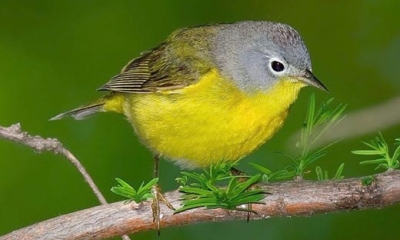
The foothills of interior southwestern Oregon come alive in late April with the bold song of this bright yellow warbler. Here it seems every brushy area or mixed conifer/hardwood forest with dense undergrowth has at least one male singing just beyond the reach of binoculars. Although it can be found in many other places in the state and in a variety of habitats, nowhere else is it as common.
Nashville's are one of the few warblers in the West to nest on the ground. They occupy diverse shrub communities, often including or adjacent to a relatively short or open tree canopy. It moves about rapidly in the understory and low in the canopy gleaning prey from leaves. Unlike eastern populations, birds of the western subspecies tent to be tail-bobbers.
It is fairly common breeding species in the interior southwest portion of the state below 4,000 feet. Nashville Warblers also breed regularly in the Columbia Gorge and along the eastern foothills of the Cascades in Wasco and Hood River counties. They are local elsewhere, including drier foothills near the southern Willamette Valley.
Hear the song of the Nashville warbler
Photo by Bill Majoros, Flickr
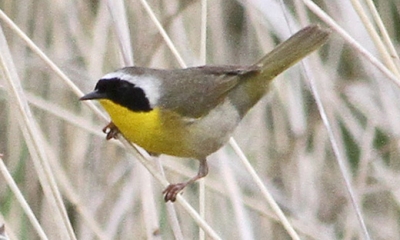
The Common yellowthroat is one of North America's most widespread warbler species and its witchity-witchity-witchity song is also among the most easily recognized.
This skulker may breed in any suitably damp brushy or weedy habitat throughout the state, and can be abundant in extensive marshy habitat. They are rare in winter in western Oregon in interior valleys and along the coast.
Hear the song of the Common yellowthroat
Photo by Kathy Munsel, ODFW
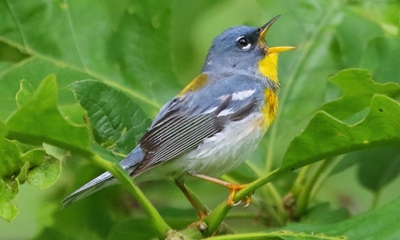
This colorful bird of coniferous forests and mixed woods is a common breeding species of eastern North America. It winters in the West Indies and Middle America and occasionally in California and the southern United States.
It is a regular migrant in very small numbers in spring and irregular in summer and fall in the southwestern United States to California and Oregon and is occasionally found elsewhere in the West. The majority of Oregon records are from late April to late June, mostly from the east of the Cascades.
Hear the song of the Northern parula
Photo by Jeff Bryant, Flickr
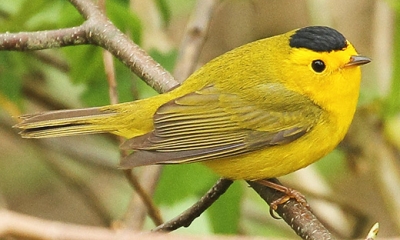
The golden-yellow face and breast of the male Wilson's warbler distinguish it as one of the brightest of Oregon's breeding warblers. Adult females are similar in plumage to males, and may even have a full black cap; however, the caps of females are smaller and duller than those of males, and are flecked with olive green.
These lively warblers nest and forage for insects in tall, dense shrub growth, understory, or riparian thickets. It is an abundant breeder in woods and tall shrubs in the Coast Range, and is common in the Willamette Valley and west Cascades.

Bringing its cheerful song to streamside thickets throughout the state each breeding season, the bright and active Yellow warbler seems to be the incarnation of summer. Notable for its vivid color, it has been described as a "rich yellow flame among the opening leaves."
It was once the most conspicuous breeding warbler in Oregon and was formerly common in shade trees of urban areas, including western Oregon, but has declined precipitously.
Hear the song of the Yellow warbler
Photo by ©Keith Kohl, ODFW
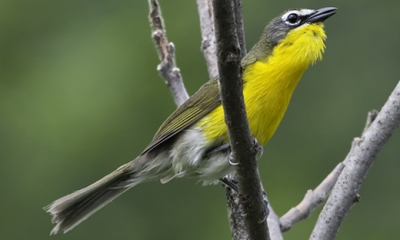
The chat's coming in the spring is like the arrival of a brass band. Male chats are loud, continuous singers, sometimes heard through the night.
Chats inhabit lowland tangles and thickets along rivers and floodplains. It is the largest of North American warblers.
In western Oregon, the chat is an uncommon to common summer resident of the interior Rogue Valley. It is a locally uncommon summer resident in the interior Umpqua Valley. In the Willamette Valley it is a locally rare to uncommon summer resident, and rare east to Oakridge. In eastern Oregon, the chat is a rare spring migrant in Klamath Basin and a locally uncommon summer resident in valley riparian areas of Harney and Malheur counties, the Deschutes and John Day River systems.
The Yellow-breasted chat is an Oregon Conservation Strategy Species in the Klamath Mountains and Willamette Valley ecoregions.
Hear the song of the Yellow-breasted chat
Photo by Kelly Colgan-Azar
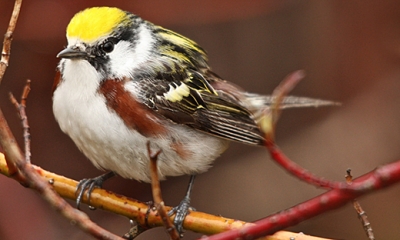
This inhabitant of riparian thickets and brushy clear-cuts and pastures breeds from northeast British Columbia across southern Canada to the east coast and south to Georgia. The main migratory route is east of the Rocky Mountains, but small numbers of transients are reported almost yearly in Oregon.
Spring records are between mid-May and mid-July. There are fewer fall records than in spring most occurring between mid-August and mid-October.
Hear the song of the Chestnut-sided warbler
Photo by Yankech Gary, Flickr
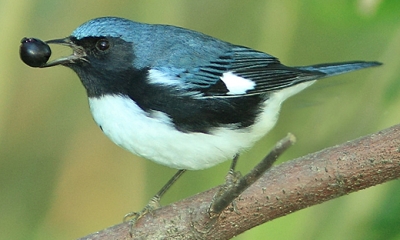
This species breeds in upland deciduous and mixed forests with dense understory from southeastern Canada south to Georgia. It winters in the Caribbean and Middle America and casually in the United States. It migrates primarily along the east coast and regularly in small numbers along the west coast.
It is rare but regular in Oregon during the fall from early September to mid-November.
Hear the song of the Black-throated warbler
Photo by Kenneth Schneider, Flickr
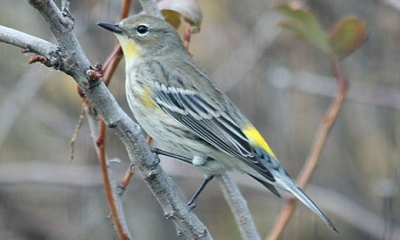
The Yellow-rumped warbler is perhaps the more familiar warbler in the state. Outside the breeding season, it can be found in almost any habitat from backyard trees in suburban areas to willow thickets in sagebrush country to the deepest coniferous forests.
It maintains a presence in the state during the winter when most other warblers have retreated to warmer climates. The brightly colored male Yellow-rumped warblers regularly descend to lower branches as they dash after insects flushed from the foliage.
Hear the song of the Yellow-rumped warbler
Photo by David Bronson
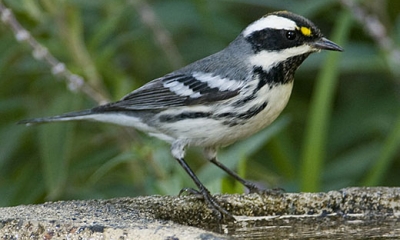
One of the first migrants to brighten Oregon woodlands with song is the Black-throated gray warbler. As early as the first week in April, the distinctive buzzy song announces the male's arrival in habitats from riparian forests to juniper woodlands, chaparral to Douglas-fir forests. It sings even as it darts through the canopy and understory in search of insects.
Except for the small yellow spot in front of the eyes, the male is an essay in black, gray and white. The cap and throat are black, as is the cheek which is outlined in white. The back is gray, striped with black, and the belly is white with black streaks along the sides. It has white wing bars and outer tail feathers that show clearly when they fly. The female is similar but the black throat patch is usually reduced or absent, ant the black cap and face are replaced by dark gray.
It is a summer resident of the foothills and valley bottoms of western Oregon thought less common in wetter areas along the coast. It extends into the Cascades in fingers of riparian forests along major rivers and in young forests, especially adjacent to the riparian corridors. Along the eastern foothills of the Cascades, it is locally common in Hood River and Wasco counties. It is occasionally seen in winter west of the Cascades.
Hear the song of the Black-throated gray warbler
Photo by Matt Knoth, Flickr
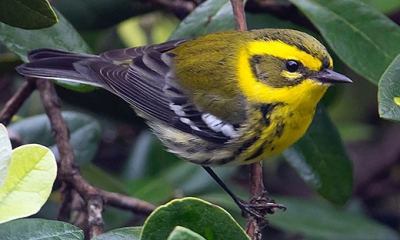
A dreary winter day can come alive with a flock of these striking birds foraging quietly in a dark green conifer. Though a common migrant and uncommon winter resident, it breeds largely to the north of Oregon.
The Townsend's warbler is a common breeder in the Blue and Wallowa mountains of northeast Oregon and a local summer resident in the vicinity of Mt. Hood and in the central Cascades.
Hear the song of the Townsend's warbler
Photo by Doug Greenberg, Flickr
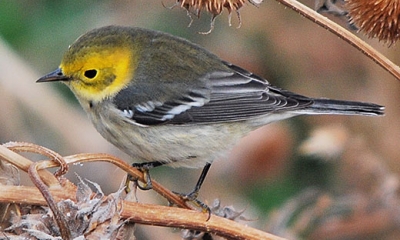
One of the most numerous breeding birds in Douglas-fir and true fir forests of western Oregon is the Hermit warbler, yet it is often overlooked. This may be surprising, given the male's bold colors; however, it seldom descends from the higher reaches of the forest canopy. If you are familiar with its song, you can often hear three to five males singing on a spring morning from many places in appropriate habitat.
The male Hermit warbler has a bright yellow head, set off by a black throat and nape. The gray back is marked with black stripes that vary in width among birds. Its belly is unmarked white, and it has white wing bars and white outer tail feathers. Females are similar, though the black on the throat is reduced or absent.
Hear the song of the Hermit warbler
Photo by John Breitsh, Flickr
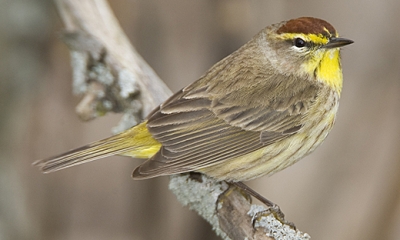
Palm warblers constantly pump their tails in a down-then-up motion, more so than any other warbler. They also walk and run on the ground more than most warblers. A key field mark is the bright yellow undertail coverts which contrast with whiter underparts. Palm Warblers are hardy warblers, migrating early in the spring and late in the fall.
Birds presumably Palm warblers are regular fall transients on the outer Oregon coast and irregularly remain through the winter and spring. They are occasional spring and fall transients in the Willamette Valley and have been found wintering there.
Hear the song of the Palm warbler
Photo by Laura Gooch, Flickr
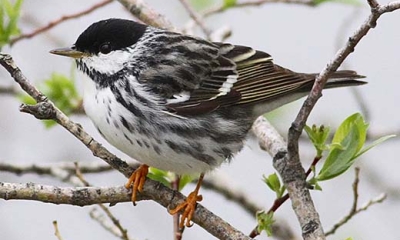
This warbler of the boreal forest breeds in Alaska and across northern Canada to the east coast and south to Pennsylvania. It migrates along the east coast to winter in South America. It is a regular transient elsewhere east of the Rocky Mountains and in California.
In Oregon it is reported in small numbers almost annually with most records being immatures from Harney County and along the immediate coast.
Hear the song of the Blackpoll warbler
Photo by D. Faulder, Flickr
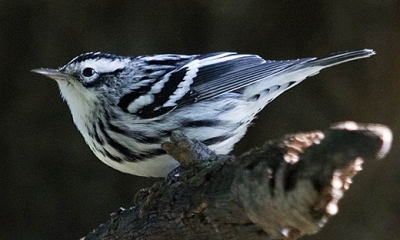
This distinctive warbler breeds in deciduous and mixed forests from southeast Yukon, east British Columbia, across Canada and through the eastern United States. It migrates east of the Rocky Mountains to winter from northern South America north to the southern United States. It is a regular transient west of the Rocky Mountains with many more spring records than fall.
Oregon spring records range from early April to mid-June. Fall records occur from mid-August to late-November.
Hear the song of the Black-and-white warbler
Photo by Howard Patterson, Flickr
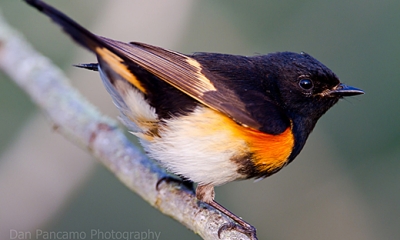
This delicate warbler rewards a diligent observer with a stunning black-and-orange vision hidden among the leaves (adult males) or a more subtle gray-and-gold (females and immatures) in riparian areas within the open forests of northeastern Oregon.
A spars, unpredictable and probably declining breeder in the state, it is sometimes seen at "vagrant traps" such as desert oases and isolated coastal copses during migration.
Hear the song of the American redstart
Photo by Dan Pacamo, Flickr

This thrush-like ground-foraging warbler breeds from southeast Yukon and eastern British Columbia across Canada and through the eastern United States and locally elsewhere east of the Rocky Mountains. It migrates east of the Rocky Mountain to winter in Middle America. It is occasionally found in winter in its breeding range and in California. Small numbers regularly occur in western North America.
Most Oregon records are from the southeast part of the state. Spring records range from early-May to mid-June. Fall records are fewer than in spring, and occur between late August and early September.
Photo by Steven Kersting, Flickr

